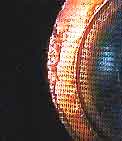CeeOn Edge: a new generation of IOL with optimal secondary cataract prevention
This lens also offers excellent optical quality and biocompatibility, reliable refraction and good handling characteristics.
 ---The Pharmacia CeeOn Edge IOL.
---The Pharmacia CeeOn Edge IOL.
The quality of a new IOL must meet certain demands, which ensure that both the patient and the surgeon will benefit for years to come. The most important criteria are: excellent optical quality and biocompatibility, reliable refraction, good handling characteristics and optimal secondary cataract prevention. We have found that the CeeOn Edge from Pharmacia Corporation (Peapack, N.J.) meets all these criteria.
CeeOn Edge is manufactured from a high refractive index silicone (polydimethyldiphenylsiloxane copolymer) with a refractive index of 1.46. The optic diameter is 6 mm, the overall diameter is 12 mm and the haptic angulation is 6°. The haptics are made of polyvinylidene fluoride and incorporate the special Cap C design (from Pharmacia Corporation), with a 90° “elbow.” Cap C haptics have very good flexibility and retentive memory. The CeeOn Edge has a smooth surface and a square truncated optic edge. The A-constant is 118.3.
Implantation of 42 CeeOn Edge IOLs
 ---Electron microscopy of optic edge.
---Electron microscopy of optic edge.
My colleague Dr. Gerstmeyer and I have implanted 42 CeeOn Edge IOLs. The patients were selected according to usual clinical study criteria. The surgical procedure was performed under local anesthesia and included Healon (sodium hyaluronate; Pharmacia Corporation), clear cornea incision (3.2 to 3.5 mm), phacoemulsification and a continuous curvilinear capsulorrhexis of about 4 to 5 mm. The CeeOn Edge was implanted with the edge of the capsulorrhexis placed over the anterior surface of the IOL.
Regarding follow-up, after 1 year, 83% of the patients were available after 1 year, 69% after 2 years, 62% after 3 years and 21% after 4 years.
The patients recovered visual acuity very quickly following surgery. After 2 and 3 years, 83% and 81% of patients respectively had a best corrected visual acuity of ³0.8 (20/25).
The intraocular pressure (IOP), which was 16.9 preoperatively, decreased by 1.5 mm after 6 months and was 16.2 after 3 years, that is, 0.7 mm lower than before surgery.
The anterior chamber depth was impressive: 2.46 mm was measured preoperatively. After implantation of the CeeOn Edge, the anterior chamber was continuously deepened — up to 3.5 mm after 3 years. This is because of the stable haptics with a retentive memory. The special Cap C haptic design keeps the capsule expanded.
The good centration of the CeeOn Edge is secured first by the special Cap C haptic design, and second by the edge of the capsulorrhexis, which is placed over the anterior surface of the IOL.
The A-constant of 118.3 correlates very well with the postoperative refraction values, which were 118.27 (first surgeon) and 118.34 (second surgeon). The spherical equivalence was constant over 3 years with no change in astigmatism.
Absence of secondary cataract
 ---Optic edge with Elschnig pearls.
---Optic edge with Elschnig pearls.
An impressive finding is the absence of secondary cataract. There are 26 eyes that have been followed up for 3 years and in no case have we found any sign of secondary cataract, and no YAG laser capsulotomy has been necessary. After 3 years, the posterior lens capsule is still clear. Also, the nine patients who have been followed-up after 4 years show no sign of secondary cataract.
In our experience, the reason for the absence of secondary cataract is the IOL design, not the IOL material. Prof. Apple’s findings and Dr. Nishi’s histological observations provide the scientific ground of this hypothesis — that the square truncated edge is the most important design detail for the prevention of secondary cataracts. Even optimal cleaning of the posterior lens capsule leaves epithelial cells at the equatorial region of the capsular bag. The movement of the capsule when pseudoaccommodating, blinking or during eye movement opens a “window” between the IOL and the posterior capsule, allowing cells to migrate behind the artificial lens. The pressure from the Cap C haptics and the square truncated edge keep the IOL stable against the posterior capsule. Thus, there is no “window” between the IOL and the capsule, and no Elschnig pearls (for example, epithelial cells) can migrate behind the IOL. Our findings and experience with the CeeOn Edge confirm these statements.
With the CeeOn Edge, we have obtained a new generation of IOL that meets the previously mentioned criteria for an optimal IOL and that will substantially help prevent the formation of secondary cataracts.
For Your Information:
- Werner H. Schmack, MD, can be reached at Lessingstrasse 2, D-32425, Minden, Germany; (49) 571-2-92-89; fax: (49) 571-88-04-09. Dr. Schmack has no direct financial interest in any of the products mentioned in this article. This study was supported by a grant from Pharmacia AB, Uppsala, Sweden.
References:
- Pharmacia Corporation can be reached at 100 Route 206 N, Peapack, NJ 07977; (908) 901-8000; fax: (908) 901-8379.
- Apple DJ, Solomon KD, Tetz MR, et al. Posterior capsule opacification. Surv Ophthalmol. 1992;7:73-116.
- Nishi O, Nishi K, Sakanishi K. Inhibition of migrating lens epithelial cells at the capsular bend created by the rectangular optic edge of a posterior chamber intraocular lens. Ophthalmic Surg Lasers. 1998;29(7):587-594.
- Nishi O. Posterior capsule opacification. Part 1: experimental investigations. J Cataract Refract Surg. 1999;25:106-117.
- Schmack WH, Gerstmeyer K. Long-term results of a new silicone intraocular lens. J Cataract Refract Surg. In press.
- Peng Q, Visessook N, Apple DJ, et al. Surgical prevention of posterior capsule opacification. Part III: intraocular lens optic barrier effect as a second line of defense. J Cataract Refract Surg. 2000;26:198-213.
